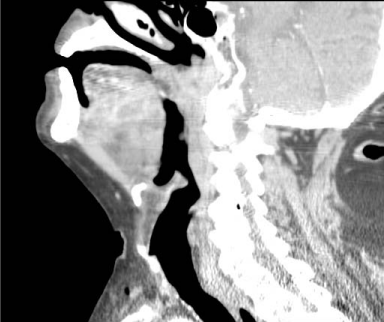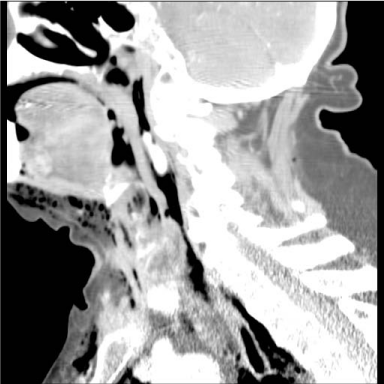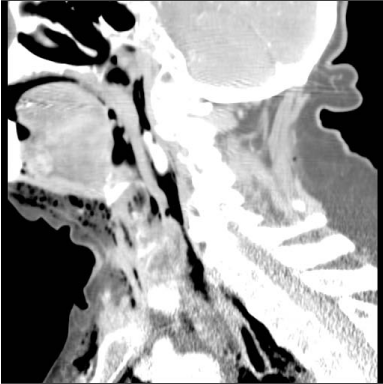Case Report
Abscess of the Tongue Evolution and Treatment of an Emergency
Bertolini G1, Bruschi A1, Meraviglia I1, Gazzano G2, Avigo C3, Luzzago F1 and Capolunghi B1*
1Department of ENT, ASST-Franciacorta, Italy
2Department of Pathology, ASST-Franciacorta, Italy
3Department of Radiology, ASST-Franciacorta, Italy
*Corresponding author: Basilio Capolunghi, Department of ENT, ASST-Franciacorta, Chiari, Brescia, Viale Mazzini, 6-25032 Chiari, Brescia, Italy
Published: 29 Sep, 2016
Cite this article as: Bertolini G, Bruschi A, Meraviglia I,
Gazzano G, Avigo C, Luzzago F, et al.
Abscess of the Tongue Evolution and
Treatment of an Emergency. Clin Surg.
2016; 1: 1143.
Abstract
The Authors present a rare case of abscess of the tongue in a 86-years-old man suffering of severe
odynophagia and dysfagia, increased snoring and tongue swelling for 15 days. A contrast-enhanced
computed tomography scan (CT scan) of the neck was performed disclosing a 4.2 x 3.2 x 3.8 cm
sized abscess at the 2/3 posterior of the body of the tongue. Due the general conditions of the
patient needle aspiration through the oral route was made consecutively for three days. The patient
experienced considerable amelioration of the symptoms. A CT scan of the neck in the 5th day after
the conservative treatment revealed an initial extension of the abscess into the hypo-pharyngeal
space. General anaesthesia and endotracheal intubation were required. Incision and drainage of the
abscesses were performed using diode laser. Tracheotomy was necessary. Complete regression of
the symptoms was experienced after 10 days.
Keywords: Abscess; Tongue; CT scan
Introduction
Abscess of the tongue is a rare pathology reported only once in the English Literature [1]. These
Authors reported lingual tonsil abscess pointing out the similar structure to that of the palatine
tonsils. However the different progression of infection is not similar because lingual tonsil lack the
capsule, thus preventing the formation of a peritonsillar abscess [1].
Acute lingual abscess is life-threatening clinical entity, as swelling of the tongue may rapidly
occlude the airway [2]. Symptoms are progressive pain, fever, swollen and immobilization of
the tongue, oedema and redness of the tongue. The most common cause of lingual abscess is
direct trauma, although immunocompromised state is a predisposing risk factor [3]. The brisk
vascularisation and muscularity of the tongue and anti-infective properties of saliva are preventing
factors to the development of the abscess [4].
Diagnosis of abscess of the tongue required enhanced Computed Tomography (CT scan) of the
neck, Ultrasound (US) through floor of mouth 4 or Magnetic Resonance Imaging (MRI). Despite
of the rarity and complexity of the condition its management strategy is relatively simple [5].
Intravenous antibiotics are the primary treatment modality, with consideration given to adjunctive
surgical drainage [3]. Differential diagnosis of the tongue abscess include haemorrhage, infarction,
tumor and edema [5].
The Authors describe a rare case of abscess of the tongue in a 86-years-old man treated initially
with conservative procedure because his general conditions; after initial ameliorations of the
symptoms patient underwent to general aenesthesia 5 days later for the extension of the abscess into
the hypo-pharyngeal space.
Case Presentation
A 86-years-old man was urgently referred to ENT department with complaints of severe odynophagia and dysfagia to solid and liquid foods for 15 days, treated with two different antibiotics without resolution of the symptoms. Tongue swelling, voice changes and increased snoring were progressively experienced. He was afebrile with normal vital signs. The white blood cell count was 16.49/mm3, C-reactive protein was 3.15 mg/L. He had no history of smoking, alcohol consumption. The patient was affected by chronic bronchitis, atrial fibrillation treated with Warfarin and implantof Pace Maker. Progressive pain involving tongue and stomatolalia were the main symptoms. A flexible endoscopic examination revealed normal larynx with no signs of airway obstruction. Tonsil were normal. Large spectrum of intravenous antibiotic and corticosteroid were initially used. A contrast-enhanced Computed Tomography scan (CT scan) of the neck was performed disclosing a 4.2 x 3.2 x 3.8 cm sized abscess at the 2/3 posterior of the body of the tongue (Figure 1). Due the general conditions of the patient needle aspiration of the pus collection through the oral route was made consecutively for three days. The patient experienced considerable amelioration of the symptoms. Pathologic examination of the pus revealed only flogistic cells. Unfortunately a CT scan of the neck in the 5th day after the conservative treatment revealed an initial extension of the abscess into the hypo-pharyngeal space (Figure 2). Thus patient underwent in the operating room. The general anaesthesia and endotracheal intubation were required. Incision and drainage of the hypopharyngeal abscess and the residual tongue lesion were performed using diode laser. Tracheotomy was necessary. The follow-up CT scan of the neck performed 10 days later the operation revealed complete disappearance of the two abscesses (Figure 3).
Figure 1
Figure 1
Sagittal CT scan of the neck disclosing abscess at the 2/3 posterior of the body of the tongue.
Figure 2
Figure 2
Sagittal CT scan of the neck performed in the 5th day after the conservative treatment. Extension of the abscess into the left hypopharyngeal space.
Figure 3
Figure 2
Sagittal CT scan of the neck after 10 days later the operation. Complete regression of the two abscesses.
Discussion
The tongue is resistant to infection because many protective
mechanisms: the increased vascularisation and lymphatic drainage,
thick keratinized mucosa, the immunological properties of saliva, and
the constant mobility which reveals cleaning effect of saliva [6]. The
tongue abscesses are classified in two groups: anterior tongue abscess
and posterior third abscess [7]. The etiologies vary according to its
localization. Posterior abscess usually derived from lingual tonsillitis,
infected thyroglossal duct cyst remnants, and periodontal infections
spreading from lower molar teeth [6,8]. Recurrent tongue abscess
were referred in case of diabetes and tongue laceration [9]. Tajudeen
et al. [10] report a case of glossal abscess as a complication of tonguebase
suspension surgery for the treatment of obstructive sleep apnea
(2011). In careful retrospective history taking, the symptoms had
dated from an episode of trauma [3,11-13].
The symptoms of tongue abscess are painful swelling of the
tongue, pain, fever, dysphagia and dyspnea. Differential diagnosis
includes: carcinomas, acute epiglottitis, dermoid cyst, lingual artery
aneurysm, infarction, haemorrhage, lingual tonsillitis, thyroglossal
cysts, tubercolosis and actinomycosis [14]. Laboratory and
radiological tests may be helpful. CT scan and MRI are recommended
for differential diagnosis of tongue swelling [9,7].
Approximately 60 cases of tongue abscess have been reported in
the English-language Literature over the past 30 years [10]. Treatment
of abscess of the tongue consists of airway maintenance, abscess
drainage, antibiotic treatment [7]. Drainage of the abscess is usually
done by needle aspiration of the pus through the inferior surface of
the tongue [15]. Gulsum et al. drained successfully the abscess of the
base of the tongue through the oral route by needle aspiration for five
consecutive days.
In our experience the abscess of the tongue was drained through
the oral cavity by needle aspiration for 3 consecutive days. The patient
experienced sensible amelioration of the symptoms. Unfortunately a
CT scan 5 days later showed initial extension of the abscess into the
hypo-pharyngeal space. Incision and drainage in the operating room
was necessary. Diode laser assisted drainage of hypo-pharyngeal
abscess and the residual tongue lesion were performed. A tracheotomy
was necessary to avoid airway compromise.
Conclusion
The tongue abscesses are rare but potentially life-threatening pathologies. The case report in this paper increase awareness among head and neck surgeons of the clinical findings of this acute pathology. The Authors consider conservative treatment the first choice leaving operative surgery in general anaesthesia in the cases of complications such as described in this issue.
References
- Coughlin AM, Baugh RF, Pine HS. Lingual tonsil abscess with parapharyngeal extension: a case report. Ear Nose Throat J. 2014; 93: E7- E8.
- Tikkakoski T, Weitz-Touretmaa A, Kamisnski T, Rahkonen M. Tongue abscess. Duodecim. 2014; 130: 71-74.
- Kettaneh N, Williamson K. Spontaneous lingual abscess in an immunocompromised patient. Am J Emerg Med. 2014; 32: 492.
- Kulkarni CD, Verma AK, Kanaujia R. A rare case of hemilingual abscess in a 17-year-old girl: the ease of ultrasound and the advantage of MRI. Jpn J Radiol. 2013; 31: 491-495.
- Pallagatti S, Sheikh S, Kaur A, Puri N, Singh R, Arya S. Tongue abscess: a rare clinical entity. J Investig Clini Dent. 2012; 3: 240-243.
- Antoniades K, Hadjipetrou L, Antoniades V, Antoniades D. Acute tongue abscess. Report of three cases. Oral Surg Oral Med Pathol Oral Radiol Endod. 2004; 97: 570-573.
- Gulsum TO, Mehemt VA, Gulhan KU, Huseyin SG. A rare case of Acute Dysphagia: Abscess of the Base of the Tongue. Case rep Gastrointest Med. 2015; 2015: 431738.
- Vellin JF, Crestani S, Saroul N, Bivahagumye L, Gabrillargues J, Gilain L. Acute abscess of the base of the tongue: a rare but important emergency. J Emerg Med. 2011; 41: e107-e110.
- Sanchez Barrueco A, Melchor Diaz MA, Jiménez Huerta I, Millan Juncos JM, Almodovar Alvarez C. Recurrent lingual abscess. Acta Otorrinolaringol esp. 2012; 63: 318-320.
- Tajudeen BA, Lanson BG, Roehm PC. Glossal abscess as a complication of tongue-base suspension surgery. Ear Nose Throat J. 2011; 90: E15-E17.
- Kim HJ, Lee BJ, Kim SJ, Shim WY, Baik SK, Sunwoo M. Tongue abscess mimicking neoplasia. AJNR Am J Neuroradiol. 2006; 27: 2202-2203.
- Westergaard-Nielse M, Ostvoll E, Wanscher JH. An abscess in the tongue. Ugerskr Laeger. 2013; 175: 1579-1580.
- Chen PL, Chiang CW, Shiao CC. Tongue abscess induced by embedded remnant fishbone. Acta Clin Belg. 2015; 70: 466-467.
- Kolb JC, Sanders DY. Lingual abscess mimicking epiglottitis. Am J Emerg Med. 1998; 16: 414-416.
- Balatsouras DG, Eliopoulos PN, Kaberos AC. Lingual abscess: diagnosis and treatment. Head Neck. 2004; 26: 550-554.



